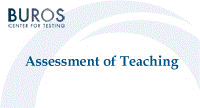Buros-Nebraska Series on Measurement and Testing

Assessment of Teaching: Purposes, Practices, and Implications for the Profession
Date of this Version
1990
Document Type
Article
Citation
From: Assessment of Teaching: Purposes, Practices, and Implications for the Profession, edited by James Y. Mitchell, Jr., Steven L. Wise, and Barbara S. Plake; Series Editor Jane Close Conoley (Hillsdale, New Jersey, Hove & London: Lawrence Erlbaum Associates, 1990)
Abstract
During the last week of July 1987,20 fourth- and fifth-grade teachers spent four days at a simulated assessment center in an elementary school. Each teacher completed 10 performance exercises on the teaching of equivalent fractions. The following week, 20 high school teachers of United States history spent four days completing a like number of exercises on the American revolution and the formation of the new government. These field tests were the culmination of over a year's work by the Teacher Assessment Project (TAP), sponsored by the Carnegie Corporation of New York, under the direction of Professor Lee S. Shulman at Stanford University.
The TAP prototype exercises represent a fundamentally new kind of teacher examination, based on structured observations of teachers' performance in situations designed to elicit the same kinds of knowledge and skills as they use in teaching, lesson planning, textbook selection, or related activities. Used in conjunction with more conventional examination formats and additional kinds of evidence (e.g., academic training or documentation of on-the-job performance), exercises based on some of these prototypes are expected to play an important role in the certification process being developed by the recently created National Board for Professional Teaching Standards. Some of the TAP prototypes directly simulate activities that are part of teaching or preparing to teach. Others, like discussing the performance of another teacher viewed on videotape, are more remote from the day-to-day work of teaching. All of the TAP exercises are designed to elicit forms of knowledge and analysis that may be critical for expert teaching.
For purposes of the TAP's research, prototypes were developed around two specific topics: the teaching of fractions, in particular the equivalence of fractions, at the upper elementary level, and the teaching of the American Revolution and the formation of the new government in a high school course on American history. Different exercises in each of these two content areas require from 45 minutes to 3 hours to complete and call on teachers to plan a lesson, critique a videotape of another teacher presenting a lesson, discuss the use of specific instructional materials, analyze and critique a textbook, or teach a lesson of their own choosing to a group of six students. Teacher examinees respond to particular student questions and comment on student homework problems (in mathematics) or brief essays (in history). Another exercise in elementary mathematics requires teachers to discuss the relationships among a set of possible topics from a unit on fractions, to select an appropriate sequence in which to teach those topics, and to explain their selection. They also demonstrate or describe methods of using specific household articles for teaching the equivalence of fractions, discuss the advantages and disadvantages of teaching students to use different methods for solving fraction problems, and describe their classroom routines for checking mathematics homework. High school history teachers engage in a group-planning exercise, in which three or four teachers work together to plan a unit on a specified topic. In another exercise, each teacher designs packets of instructional materials for a particular form of cooperative group learning activity. The 1987 field tests of these exercises yielded a rich and extensive data base. In two weeks, they generated roughly 200 videotapes, 400 audiotapes, several thousand pages of observer notes, and hundreds of pages of notes and other writing by the 40 participating teachers themselves.
Included in
Educational Administration and Supervision Commons, Educational Assessment, Evaluation, and Research Commons


Comments
Copyright © 1990 by Lawrence Erlbaum Associates, Inc. Digital Edition Copyright © 2012 Buros Center for Testing. This book may be downloaded, saved, and printed by an individual for their own use. No part of this book may be re-published, re-posted, or redistributed without written permission of the holder of copyright.